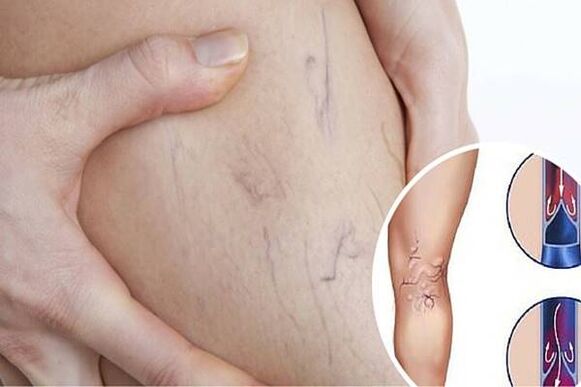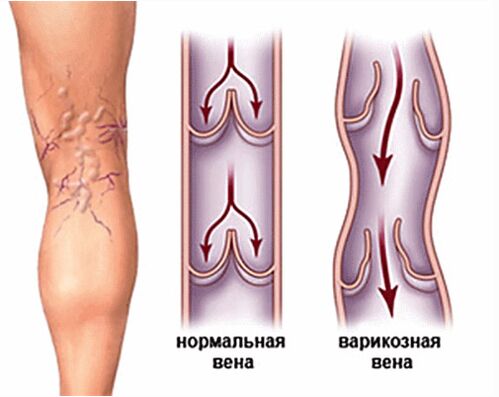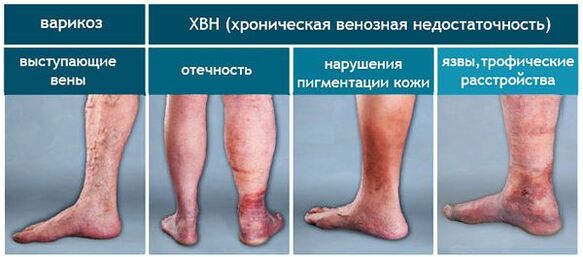According to statistics, about 83% of the population faces disease such as varicose veins of lower extremities.Therefore, it is important to know how varicose veins in the initial phase look.This will identify the disease in a timely manner and prevent the development of possible complications.

Types of varicose veins
Venus disease, which is accompanied by their expansion, the destruction of the valve apparatus may affect different body authorities.Therefore, the classification of this pathology is based on the place of its localization.
According to the international classification of diseases 10. views, such types of diseases differ:
- Varicose veins of blood circulation systems.
- Expansion of the venus of the digestive tract.
- Accumulation of numerous pathological clots in one place.
- Varicosis of lymph nodes and containers that are not systematized in other sections.
- Varicose spread of lower extremities.
The use of the ICD 10 in medical practice allows the flexibility to create an appropriate diagnosis and differentiation of varicose veins.
In return, varicose veins on the lower extremities, depending on the stage of the object, are classified into disease with:
- Ulcer lesions.
- Progressive inflammatory processes.
- Ulcer and inflammation.
- Varicose leg veins or other part with skin damage.
- Lack of vein deformations with ulcer, inflammatory processes.
Taking into account the main places of localization of pathological changes, varicose veins differ:
- Surface veins.
- Deep veins.
- Reticular.
Extensive classification of varicose veins is determined by a wide range of options for the disease course.In the differentiation of pathology, modern doctors use not only ICD-10, but also the classification of disease by forms.
In medical practice, such forms of varicose veins differ:
- Partial damage to the blood vessels of subcutaneous and intradermal type without reverse outflows.
- Segmental defeat with reverse outflow of blood in all veins.
- Extensive defeat with discharging pathological etiology in subcutaneous veins.
- The usual lesion of veins with abnormal emptying through deep veins.
Deformation in vein and dysfunction in them blood flow can be of several species.Only a doctor is able to diagnose properly and establish the type of varicose expansion of the results of the complex test.

Degree of varicose veins
Depending on the process of advancing the disease, varicose veins have 4 stages of development.Each of them is characterized by certain symptoms.
- In the first phase, the severity of the legs and pain of painful nature feels.Visualized vascular stars, veins and swelling of the knot.It is possible in non-chestnut spasms of the calf muscle and the ignition manifestation in the foot space.It is characterized by the absence of stagnation in the bloodstream.
- The second degree of varicose veins was followed by oxygen hunger with a venous system.It is characterized by a quick increase in size and number of vascular nodes and stars.Such damage clearly expressed the boundaries, which contributes to their brighter event.Maybe their grouping is in the same area of defeat a little behind the area.In this case, the pain and swelling of soft tissues are improving.
- With the third degree of varicose veins, trophic lesions of the medial surface of the lower leg are formed.It is characterized by the look of brown surfaces on the skin, which, with the progression of the disease covered with dry bark and cracks.Dermatitis is possible against their background.The presence of great edema becomes dangerous.There are a lot of fatigue and pain.
- The fourth degree is the complications of the disease.They may appear in the form of inflammatory process development, trophic rectors on vein walls.Bleeding is possible with mechanical seal impairments.This degree is dangerous with the possibility of developing a venous insufficiency, which can subsequently acquire a chronic form.
In the third and fourth phase, the patient begins to experience severe pain of different nature, both in the muscles and along Venian trunks.It is extremely rare, there may be cracked nodes, accompanied by insignificant blood loss.Most often such a sign is manifested at night.If, with varicose veins, hyperthermia appeared and increased weakness, it directly indicates the emergence of disease complications.
Varicose itself is not a dangerous disease that is not subject to therapy.But it is worth noting that this pathology does not go on its own, and progress quickly.Identification of first-degree varicose veins significantly increases the provisions of fast and successful recovery.Launched varicose veins of the fourth degree is dangerous for the body and human life.

Stages of varicose veins of the lower extremities
Varicose veins are characterized by several phases of pathology.Of which each determines the prevalence of the disease and has certain characteristics.There are many classifications phases of varicose veins, each with their own symptoms and therapy.Most in professional practice, modern doctors use the classification of varicose veins according to the degree of change in blood flow in bodies.
The following stages of the disease differ:
- It is characterized by the presence of a cosmetic manifestation problem.There are no symptoms of thrombosis, but when testing the patient, there are signs of the initial phase of varicose vein on their feet.Depending on the etiology of pathology, the stage of varicose vein compensation without adequate treatment throughout the year can develop into second-degree varicose veins.
- Blood vessels are subject to deformation and are clearly manifested on the surface of the leg.The varicose of this phase was accompanied by pain and swelling of the lower extremities.There is a sense of seriousness, a feeling of cracking and significantly increases skin sensitivity.Swelling on the legs is enhanced in the evening, and the next morning disappears.
- Visual signs of pathologists increase significantly.Ven-nets and nodes don't just become just in space, but also in quantity.An intensive sensation appears.The surface of the skin gains a dark shade, becomes dry and shiny.At this stage, there is little bleeding, which causes chemosider deposition, leading to skin hyperpigmentation in affected areas.
The initial phase of varicose veins for each organism continues differently.The intensity of the manifestation of its symptoms and the duration of this period is individual and depends on many factors.Therefore, with the manifestation of the smallest signs of pathology, you should immediately seek qualified medical care.Timely treatment will prevent the development of more serious phases of varicose veins.
Home Phase of varicose veins on top: treatment of pathology
With varicose veins, the efficiency of the therapeutic course is directly dependent on the timely manner of the pathology.Qualified medical care in the initial phase of disease development allows you to return the integrity of the vascular wall and the functionality of the damaged veins.
The treatment of varicose veins of the initial phase is done comprehensively and consists of:
- Complex drug use.For complex effects on veins, oral intake is made by preparation of tablets.The use of local fat-shaped medications and gels has a high therapeutic effect.
- Sclerotherapy.After the proceedings, the obligatory carrying of a special compression knitting.Sclerotherapy efficiency explains its use in the fee stage for varicose veins of the lower extremities.
- Ozonotherapy.Refers to treatment, which acts as one of the components of the complex therapy with varicose veins in the initial phase.Such procedures improve oxygen cell nutrition and stimulate blood circulation through veins.As a result, pasting the affected walls of blood vessels.
Each of the methods of therapy for varicose veins requires mandatory medical recipe and control.The self-confidence of varicose veins is strictly prohibited.
Varicose veins on the lower extremities of the initial degree is difficult to diagnose independently.Visual information on the Internet contributes to visual dating with the characteristic signs of pathology.


















